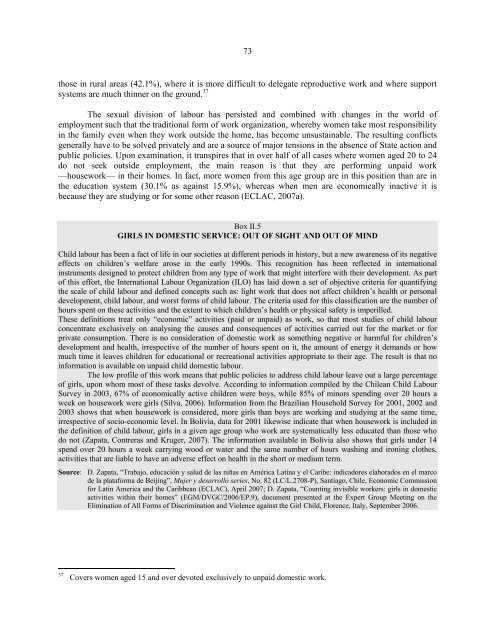Women in Latin America and the Caribbean - Cepal
Women in Latin America and the Caribbean - Cepal
Women in Latin America and the Caribbean - Cepal
Create successful ePaper yourself
Turn your PDF publications into a flip-book with our unique Google optimized e-Paper software.
73<br />
those <strong>in</strong> rural areas (42.1%), where it is more difficult to delegate reproductive work <strong>and</strong> where support<br />
systems are much th<strong>in</strong>ner on <strong>the</strong> ground. 37<br />
The sexual division of labour has persisted <strong>and</strong> comb<strong>in</strong>ed with changes <strong>in</strong> <strong>the</strong> world of<br />
employment such that <strong>the</strong> traditional form of work organization, whereby women take most responsibility<br />
<strong>in</strong> <strong>the</strong> family even when <strong>the</strong>y work outside <strong>the</strong> home, has become unsusta<strong>in</strong>able. The result<strong>in</strong>g conflicts<br />
generally have to be solved privately <strong>and</strong> are a source of major tensions <strong>in</strong> <strong>the</strong> absence of State action <strong>and</strong><br />
public policies. Upon exam<strong>in</strong>ation, it transpires that <strong>in</strong> over half of all cases where women aged 20 to 24<br />
do not seek outside employment, <strong>the</strong> ma<strong>in</strong> reason is that <strong>the</strong>y are perform<strong>in</strong>g unpaid work<br />
—housework— <strong>in</strong> <strong>the</strong>ir homes. In fact, more women from this age group are <strong>in</strong> this position than are <strong>in</strong><br />
<strong>the</strong> education system (30.1% as aga<strong>in</strong>st 15.9%), whereas when men are economically <strong>in</strong>active it is<br />
because <strong>the</strong>y are study<strong>in</strong>g or for some o<strong>the</strong>r reason (ECLAC, 2007a).<br />
Box II.5<br />
GIRLS IN DOMESTIC SERVICE: OUT OF SIGHT AND OUT OF MIND<br />
Child labour has been a fact of life <strong>in</strong> our societies at different periods <strong>in</strong> history, but a new awareness of its negative<br />
effects on children’s welfare arose <strong>in</strong> <strong>the</strong> early 1990s. This recognition has been reflected <strong>in</strong> <strong>in</strong>ternational<br />
<strong>in</strong>struments designed to protect children from any type of work that might <strong>in</strong>terfere with <strong>the</strong>ir development. As part<br />
of this effort, <strong>the</strong> International Labour Organization (ILO) has laid down a set of objective criteria for quantify<strong>in</strong>g<br />
<strong>the</strong> scale of child labour <strong>and</strong> def<strong>in</strong>ed concepts such as: light work that does not affect children’s health or personal<br />
development, child labour, <strong>and</strong> worst forms of child labour. The criteria used for this classification are <strong>the</strong> number of<br />
hours spent on <strong>the</strong>se activities <strong>and</strong> <strong>the</strong> extent to which children’s health or physical safety is imperilled.<br />
These def<strong>in</strong>itions treat only “economic” activities (paid or unpaid) as work, so that most studies of child labour<br />
concentrate exclusively on analys<strong>in</strong>g <strong>the</strong> causes <strong>and</strong> consequences of activities carried out for <strong>the</strong> market or for<br />
private consumption. There is no consideration of domestic work as someth<strong>in</strong>g negative or harmful for children’s<br />
development <strong>and</strong> health, irrespective of <strong>the</strong> number of hours spent on it, <strong>the</strong> amount of energy it dem<strong>and</strong>s or how<br />
much time it leaves children for educational or recreational activities appropriate to <strong>the</strong>ir age. The result is that no<br />
<strong>in</strong>formation is available on unpaid child domestic labour.<br />
The low profile of this work means that public policies to address child labour leave out a large percentage<br />
of girls, upon whom most of <strong>the</strong>se tasks devolve. Accord<strong>in</strong>g to <strong>in</strong>formation compiled by <strong>the</strong> Chilean Child Labour<br />
Survey <strong>in</strong> 2003, 67% of economically active children were boys, while 85% of m<strong>in</strong>ors spend<strong>in</strong>g over 20 hours a<br />
week on housework were girls (Silva, 2006). Information from <strong>the</strong> Brazilian Household Survey for 2001, 2002 <strong>and</strong><br />
2003 shows that when housework is considered, more girls than boys are work<strong>in</strong>g <strong>and</strong> study<strong>in</strong>g at <strong>the</strong> same time,<br />
irrespective of socio-economic level. In Bolivia, data for 2001 likewise <strong>in</strong>dicate that when housework is <strong>in</strong>cluded <strong>in</strong><br />
<strong>the</strong> def<strong>in</strong>ition of child labour, girls <strong>in</strong> a given age group who work are systematically less educated than those who<br />
do not (Zapata, Contreras <strong>and</strong> Kruger, 2007). The <strong>in</strong>formation available <strong>in</strong> Bolivia also shows that girls under 14<br />
spend over 20 hours a week carry<strong>in</strong>g wood or water <strong>and</strong> <strong>the</strong> same number of hours wash<strong>in</strong>g <strong>and</strong> iron<strong>in</strong>g clo<strong>the</strong>s,<br />
activities that are liable to have an adverse effect on health <strong>in</strong> <strong>the</strong> short or medium term.<br />
Source: D. Zapata, “Trabajo, educación y salud de las niñas en América Lat<strong>in</strong>a y el Caribe: <strong>in</strong>dicadores elaborados en el marco<br />
de la plataforma de Beij<strong>in</strong>g”, Mujer y desarrollo series, No. 82 (LC/L.2708-P), Santiago, Chile, Economic Commission<br />
for Lat<strong>in</strong> <strong>America</strong> <strong>and</strong> <strong>the</strong> <strong>Caribbean</strong> (ECLAC), April 2007; D. Zapata, “Count<strong>in</strong>g <strong>in</strong>visible workers: girls <strong>in</strong> domestic<br />
activities with<strong>in</strong> <strong>the</strong>ir homes” (EGM/DVGC/2006/EP.9), document presented at <strong>the</strong> Expert Group Meet<strong>in</strong>g on <strong>the</strong><br />
Elim<strong>in</strong>ation of All Forms of Discrim<strong>in</strong>ation <strong>and</strong> Violence aga<strong>in</strong>st <strong>the</strong> Girl Child, Florence, Italy, September 2006.<br />
37<br />
Covers women aged 15 <strong>and</strong> over devoted exclusively to unpaid domestic work.











